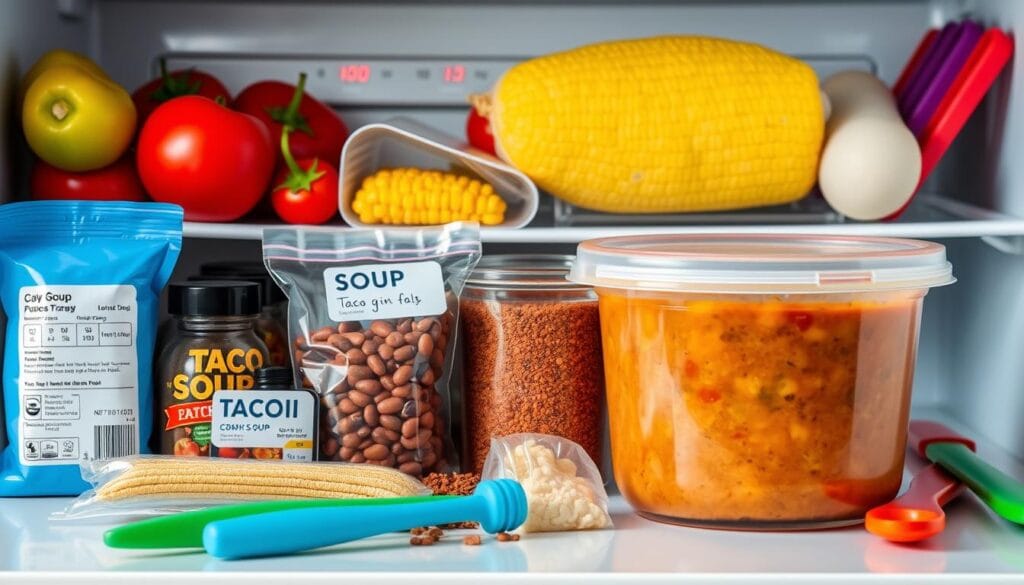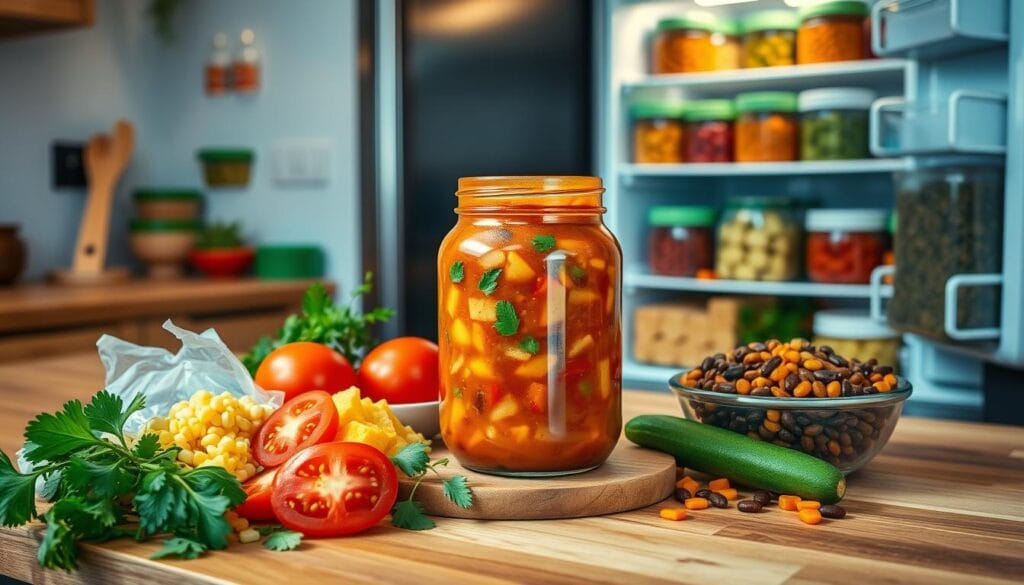Last weekend, I made my favorite taco soup. It reminded me of family gatherings and cozy dinners. Many home cooks struggle with storing this dish safely.
It is more than a meal. It’s a comfort food that brings warmth and memories. Knowing how to store it safely is important. It helps you enjoy every last spoonful and keeps your family safe.
Understanding taco soup’s shelf life is key. It’s not just about keeping the flavor. It’s about keeping your loved ones healthy and safe. Let’s explore the essential storage tips for this beloved dish.
Key Takeaways
- Taco soup typically lasts 3-4 days in the refrigerator
- Proper storage is crucial for maintaining food quality and safety
- Always use airtight containers for refrigerator storage
- Check for signs of spoilage before consuming leftovers
- Refrigerate soup within two hours of cooking
Understanding Taco Soup Shelf Life Basics

Enjoying your taco soup means knowing its shelf life, as this is key for keeping it safe and tasty. Proper storage plays a crucial role in maintaining the quality and extending the life of this delicious dish.
Components Affecting Storage Duration
The ingredients in your recipe are very important. They decide how long it can stay good. The main things that matter are:
- Ground beef protein content
- Canned vegetables and beans
- Liquid base components
Safe Storage Temperature Requirements
Keeping your taco soup in the fridge is essential. It should be stored at 40°F (4°C) or colder. This stops bacteria from growing and keeps it safe to eat.
| Storage Location | Maximum Safe Duration |
|---|---|
| Refrigerator | 3-4 days |
| Freezer | 3-6 months |
Signs of Freshness and Quality
To make sure your taco soup is still good, look for these signs:
- Vibrant color
- Pleasant aroma
- No visible mold
- Consistent texture
“Proper storage is the key to maintaining your taco soup’s delicious flavor and nutritional value.”
Proper Refrigeration Guidelines for Taco Soup

Learning how to store taco soup in the fridge keeps it safe and tasty. Following food safety tips helps keep your soup fresh and enjoyable.
Here are key steps for storing it:
- Cool the soup to room temperature before refrigerating
- Use airtight containers to prevent bacterial growth
- Place soup in the coldest part of the refrigerator
- Divide large batches into smaller portions
“Proper storage is the key to maintaining the flavor and safety of your taco soup.” – Culinary Food Safety Expert
Choosing the right container is important. Glass or BPA-free plastic containers with tight-fitting lids are best. They keep the soup fresh and prevent contamination.
Keeping the fridge at or below 40°F (4°C) is key for safety. This allows your taco soup to stay fresh for up to a week.
- Maximum refrigerator storage: 7 days
- Recommended container type: Airtight sealed containers
- Ideal storage location: Bottom shelf of refrigerator
Always check for spoilage before eating stored taco soup. If it smells bad or has mold, throw it away to stay safe.
Maximum Storage Time in the Refrigerator
Storing taco soup safely means knowing food safety rules and how to keep it cold. How long your soup lasts depends on a few key factors, which affect its quality and safety.
Getting the right fridge temperature and using the right containers is important. The FDA has clear rules to keep your soup fresh and safe from illness.
FDA Food Safety Guidelines
The FDA says taco soup can stay in the fridge for a certain amount of time:
- Maximum refrigeration time: 3-4 days
- Recommended refrigerator temperature: 40°F (4°C) or below
- Critical storage rule: Cool soup quickly before refrigerating
Temperature Control Importance
Keeping the fridge at a steady temperature is key. Temperature changes can make bacteria grow fast. This can make your it unsafe. Use a fridge thermometer to keep it at 40°F or lower.
Container Selection Tips
Picking the right containers is important for keeping your soup fresh:
- Select shallow, airtight containers
- Use glass or BPA-free plastic containers
- Avoid deep containers that slow-cooling
“Proper storage is the key to maintaining your taco soup’s flavor and safety.” – Food Safety Expert
Pro tip: Always label your containers with the date of preparation to track storage time accurately.
Best Practices for Storing Taco Soup
Learning how to store this recipe right can make it taste even better. It also keeps it safe to eat. By following good storage tips, you can enjoy your taco soup again and again.
- Use airtight glass or ceramic containers for storage
- Always label containers with the preparation date
- Cool soup completely before refrigerating
- Divide into smaller portions for easier reheating
“The key to great taco soup is not just in the cooking, but in the careful storage.” – Professional Chef
How long you can store taco soup depends on how you keep it:
| Storage Method | Duration | Recommended Conditions |
|---|---|---|
| Refrigerator | 3-4 days | Airtight container, below 40°F |
| Freezer | 2-3 months | Freezer-safe container, 0°F or lower |
Pro tip: Don’t use metal containers for your soup. Acidic ingredients can react with metal and change the taste. Also, keep the soup away from raw meats to avoid contamination.
By using these storage tips, you’ll keep your taco soup tasty and safe. You’ll also reduce food waste.
Bake sliced beef recipes or discover shaved beef recipe ideas.
Ingredients and Their Impact on Storage
When making taco soup, knowing how ingredients affect storage is key. Each part plays a special role in keeping the soup fresh and lasting longer.
Your soup has many ingredients that affect how long it stays good. Let’s look at how different parts impact storage and safety.
Meat-Based Components
Ground beef is a main part of taco soup and needs careful handling. Make sure the meat is cooked to 160°F to kill bacteria. Cooked ground beef stays safe in the fridge for 3-4 days.
- Brown meat completely before adding to soup
- Cool meat rapidly before refrigeration
- Store in shallow containers for quick cooling
Vegetable Preservation
Vegetables like tomatoes and corn help keep the soup stable. Their acidity slows down bacterial growth during storage.
| Vegetable | Storage Impact | Recommended Storage Time |
|---|---|---|
| Diced Tomatoes | Increases acidity, helps preservation | 3-4 days refrigerated |
| Corn | Maintains texture, minimal spoilage risk | 3-4 days refrigerated |
Bean and Legume Considerations
Beans soak up liquid, making your taco soup thicker. Dry beans can last 30 years if stored right.
“Proper storage techniques can significantly extend the life of your taco soup ingredients.” – Food Safety Expert
When storing taco soup, keep cheese and sour cream separate. This helps keep them fresh and prevents spoilage.
Signs Your Taco Soup Has Gone Bad
It’s important to know when food has gone bad to keep leftovers safe and healthy. Taco soup is no exception. There are specific signs to look out for to decide if your soup is still good to eat or if it’s time to throw it away.
Here are the main signs of spoilage in taco soup:
- Unusual Odors: A sour or off smell is a clear warning
- Visible Mold: Any green, white, or black fuzzy growth means it’s time to toss it
- Texture Changes: Sliminess or unexpected separation of ingredients means it’s gone bad
- Color Modifications: Big color changes from the original soup color suggest spoilage
Soup quality drops quickly after it’s stored. Generally, it should be eaten within 3-4 days. This time can vary based on the ingredients. Soups with meat tend to spoil faster than those without.
“When in doubt, throw it out” – Food safety experts say it’s better to be safe than sorry with potentially spoiled food.
Remember these storage times:
- Ground beef or turkey taco soup: 3-4 days
- Chicken taco soup: Up to 3 days
- Vegetarian taco soup: 5-6 days
Keeping your soup in the fridge at or below 40°F (4°C) is key. Always use clean, airtight containers. Refrigerate your taco soup right after cooking.
Freezing Taco Soup for Extended Storage
Freezer storage is a great way to keep your taco soup fresh. Learning how to preserve it long-term means you can enjoy it weeks later.
Taco soup can stay good in the freezer for up to three months. It keeps its taste and nutrients well. But, you need to prepare it right to keep it tasty and safe.
Freezer Container Options
Choosing the right container is important for freezing soup. Here are some good choices:
- BPA-free plastic containers with tight-fitting lids
- Tempered glass containers made for freezing
- Heavy-duty freezer bags for saving space
- Zip-top gallon-sized bags for flat-freezing
Proper Labeling Methods
Good labeling helps you keep track of your soups. Always write the soup type and freezing date to stay organized and safe.
“Label it, date it, know it!” – Freezer Storage Experts
Thawing Techniques
Thawing safely is key to keeping your soup quality. Here are the best ways to thaw:
- Refrigerator thawing (recommended): Move soup from the freezer to the fridge 24-48 hours before eating
- Warm water bath: Put sealed container in warm water
- Avoid thawing in the microwave, especially in plastic
Pro tip: Freeze soup in smaller amounts for easier thawing and reheating. This way, you can enjoy fresh taco soup whenever you want without wasting food.
Reheating Stored Taco Soup Safely
Reheating taco soup needs careful attention to keep its taste and ensure safety. The right way to reheat is through microwave safety and stovetop reheating. These methods require proper temperature control and technique.
Here are the best ways to reheat your taco soup:
- Microwave Method
- Use a microwave-safe bowl
- Stir soup every 30 seconds
- Ensure even heat distribution
- Check internal temperature reaches 165°F (74°C)
- Stovetop Reheating
- Use medium heat setting
- Stir frequently to prevent scorching
- Add a small amount of water or broth if soup has thickened
- Monitor temperature with a food thermometer
“Proper reheating isn’t just about warming your food—it’s about preserving its taste and ensuring your safety.” – Food Safety Expert
Remember, reheating too many times can lower the soup’s quality. It’s best to reheat only what you’ll eat right away. Using fresh ingredients and careful reheating will keep your taco soup’s flavors bright.
Tips to Extend Taco Soup Freshness
Learning how to preserve food can make meal prep easier. To keep taco soup fresh, plan and use smart storage. This helps keep the flavor and nutrients intact.
Cooling your taco soup quickly is key. It stops bacteria from growing and keeps the soup tasting great.
Smart Cooling Techniques
- Divide hot soup into smaller portions
- Use shallow containers for faster cooling
- Place pot in an ice bath to reduce temperature quickly
- Avoid leaving soup at room temperature for over 2 hours
Strategic Portioning Strategies
Portioning your taco soup wisely makes meal prep simple. Small servings reduce bacterial risk and make reheating easy.
| Portion Size | Storage Duration | Recommended Use |
|---|---|---|
| 1-2 cup servings | 4-5 days refrigerated | Quick lunch or dinner |
| Freezer portions | Up to 3 months | Long-term meal planning |
Selecting the Perfect Storage Containers
The right container is crucial for keeping food fresh. Choose high-quality, airtight ones that block odors and keep food fresh.
*”The right container is your taco soup’s best defense against spoilage”*
- Glass containers with tight-fitting lids
- BPA-free plastic containers
- Containers with clear measurements
- Freezer-safe options for long-term storage
Using these tips can help your taco soup last longer. You’ll enjoy every bite as much as the first one.
Food Safety Guidelines for Leftover Soups
Keeping your family healthy starts with good leftover management. It’s important to follow food hygiene and kitchen safety rules when dealing with soups.
The USDA has clear tips for keeping your leftover taco soup safe and tasty. Here are some key steps to stop bacteria from growing and keep your food fresh:
- Refrigerate soup within two hours of cooking
- Use clean utensils when serving
- Store in airtight containers
- Monitor storage temperatures carefully
“Food safety isn’t expensive, it’s priceless” – Unknown
Keeping track of your leftover soup’s freshness is important. Different soups need different storage times:
| Soup Type | Refrigerator Storage | Freezer Storage |
|---|---|---|
| Creamy Soups | 3 days | 1-2 months |
| Broth-Based Soups | 3-4 days | 2-3 months |
Your kitchen safety plan should always aim to avoid foodborne illnesses. Always look out for signs of spoilage:
- Unusual odors
- Mold growth
- Slimy texture
- Unusual color changes
If you’re unsure, it’s best to throw it away. Keeping your family safe is more important than saving a batch of soup.
Discover Alice Springs Chicken Recipe and try this delicious split chicken breast recipe today
Common Storage Mistakes to Avoid
Storing the soup can be tricky. Knowing the right kitchen practices is key to avoiding health risks and keeping your meals tasty.
There are several mistakes to watch out for when keeping soup fresh. Here are the most common ones:
- Storing soup in refrigerator door shelves where temperature fluctuates
- Placing hot soup directly into the refrigerator
- Repeatedly reheating entire soup batches
- Relying solely on appearance or smell to determine safety
“Food safety starts with proper storage techniques and understanding potential risks.” – Food Safety Experts
Keeping the right temperature is key to stop bacteria from growing. The danger zone between 40°F and 140°F is perfect for harmful bacteria to grow fast.
| Storage Location | Maximum Safe Storage Time | Recommended Temperature |
|---|---|---|
| Refrigerator | 3-4 days | Below 40°F |
| Freezer | Up to 3 months | 0°F or lower |
To keep your taco soup fresh, cool it down fast before putting it in the fridge. Use shallow containers for quick cooling and to avoid temperature changes. Always use clean utensils to serve to avoid contamination.
Good food storage is not just about keeping food longer. It’s about keeping you healthy and enjoying your meals with confidence.
Conclusion
Learning how to store taco soup is key for keeping food safe and managing your kitchen well. The way you store this tasty dish can greatly affect its taste and health benefits. By sticking to the recommended steps, you’ll keep every batch of taco soup delicious and safe to eat.
Proper storage of taco soup includes a few important steps. First, cool it down within two hours of cooking. Then, use airtight containers and keep it cold, below 40°F. This rule applies to both meat and vegan versions. Your soup can stay good in the fridge for 3-4 days. Freezing it can extend its life to 2-3 months.
Being careful about food safety is part of smart kitchen management. Watch for signs of spoilage, like bad smells or looks. Always handle food safely. This careful approach helps avoid food illnesses and keeps your taco soup tasting great.
Knowing how to store taco soup gives you peace of mind. It helps you pick the right containers and know how long to keep your soup. These tips make cooking and enjoying your favorite soup safer and more fun.
FAQs
How long can I safely store taco soup in the refrigerator?
Taco soup can stay in the fridge for 3-4 days. Keep it in an airtight container at 40°F (4°C) or below. Always check for spoilage signs and follow food safety rules.
What are the signs that taco soup has gone bad?
Watch for mold, off-odors, sliminess, or color changes. If you see these, throw the soup out to avoid illness.
Can I freeze taco soup for longer storage?
Yes, freeze it for 3-6 months. Use containers or bags made for freezing, leaving space for expansion. Label them with what’s inside and when you froze it.
What’s the best way to store taco soup?
Keep it in shallow, airtight containers in the fridge’s coldest spot. Cool it down before refrigerating. Divide big batches into smaller ones for faster cooling and reheating.
How should I reheat stored taco soup?
Heat to 165°F (74°C). Use a microwave-safe bowl or the stovetop. Add a bit of water if it’s too thick.
Are there any ingredients I should store separately?
Store cheese and sour cream separately to keep them fresh. Beans might make the soup thicker, so add fresh toppings when serving.
What containers are best for storing taco soup?
Choose glass or BPA-free plastic containers with tight lids. Avoid metal because acidic ingredients can react with it. Make sure containers are airtight to keep it fresh.
How quickly should I refrigerate taco soup after cooking?
Cool it within 2 hours of cooking. Use an ice bath or divide it to cool faster and prevent bacteria.

